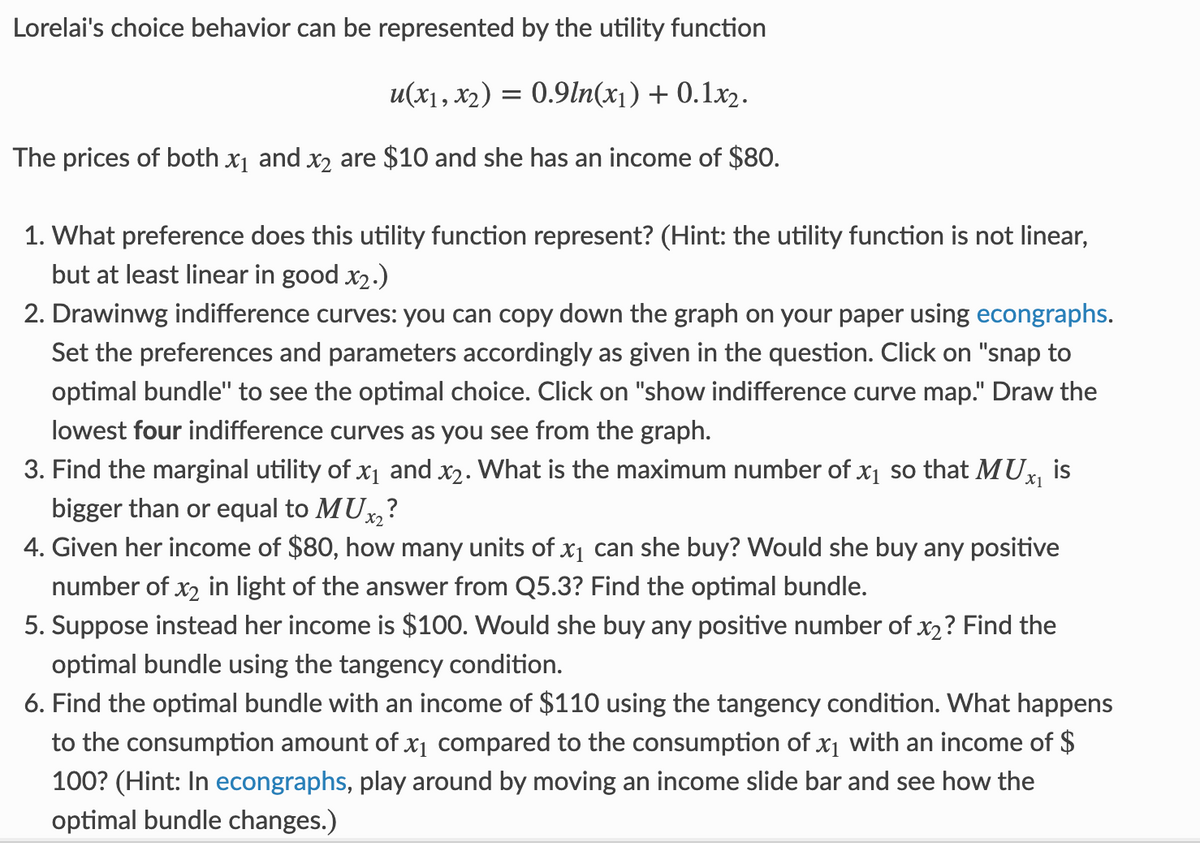What preference does this utility function represent? (Hint: the utility function is not linea but at least linear in good x₂.) Drawinwg indifference curves: you can copy down the graph on your paper using econgrap Set the preferences and parameters accordingly as given in the question. Click on "snap to optimal bundle" to see the optimal choice. Click on "show indifference curve map." Draw th lowest four indifference curves as you see from the graph. . Find the marginal utility of x₁ and x2. What is the maximum number of x₁ so that MUX₁ is bigger than or equal to MUx₂? Given her income of $80, how many units of x₁ can she buy? Would she buy any positive number of x₂ in light of the answer from Q5.3? Find the optimal bundle. Suppose instead her income is $100. Would she buy any positive number of x₂? Find the optimal bundle using the tangency condition. Find the optimal bundle with an income of $110 using the tangency condition. What happ
What preference does this utility function represent? (Hint: the utility function is not linea but at least linear in good x₂.) Drawinwg indifference curves: you can copy down the graph on your paper using econgrap Set the preferences and parameters accordingly as given in the question. Click on "snap to optimal bundle" to see the optimal choice. Click on "show indifference curve map." Draw th lowest four indifference curves as you see from the graph. . Find the marginal utility of x₁ and x2. What is the maximum number of x₁ so that MUX₁ is bigger than or equal to MUx₂? Given her income of $80, how many units of x₁ can she buy? Would she buy any positive number of x₂ in light of the answer from Q5.3? Find the optimal bundle. Suppose instead her income is $100. Would she buy any positive number of x₂? Find the optimal bundle using the tangency condition. Find the optimal bundle with an income of $110 using the tangency condition. What happ
Microeconomics A Contemporary Intro
10th Edition
ISBN:9781285635101
Author:MCEACHERN
Publisher:MCEACHERN
Chapter6: Consumer Choice And Demand
Section6.A: Appendix: Indifference Curves And Utility Maximization
Problem 2AQ
Related questions
Question
Subpart 7 only

Transcribed Image Text:7. Will the optimal bundle be the same or different if the utility function were
u(x1, x₂) =
Explain.
: 9ln(x₁) + x2? What if the utility function were u(x₁, x₂) = x₁ × exp(x₂)?

Transcribed Image Text:Lorelai's choice behavior can be represented by the utility function
u(x1, x₂) = 0.9ln(x₁) + 0.1x2.
The prices of both x₁ and x₂ are $10 and she has an income of $80.
1. What preference does this utility function represent? (Hint: the utility function is not linear,
but at least linear in good x₂.)
2. Drawinwg indifference curves: you can copy down the graph on your paper using econgraphs.
Set the preferences and parameters accordingly as given in the question. Click on "snap to
optimal bundle" to see the optimal choice. Click on "show indifference curve map." Draw the
lowest four indifference curves as you see from the graph.
3. Find the marginal utility of x₁ and x₂. What is the maximum number of x₁ so that MUX₁ is
bigger than or equal to MUX₂
4. Given her income of $80, how many units of x₁ can she buy? Would she buy any positive
number of x₂ in light of the answer from Q5.3? Find the optimal bundle.
5. Suppose instead her income is $100. Would she buy any positive number of x2? Find the
optimal bundle using the tangency condition.
6. Find the optimal bundle with an income of $110 using the tangency condition. What happens
to the consumption amount of x₁ compared to the consumption of x₁ with an income of $
100? (Hint: In econgraphs, play around by moving an income slide bar and see how the
optimal bundle changes.)
Expert Solution
This question has been solved!
Explore an expertly crafted, step-by-step solution for a thorough understanding of key concepts.
This is a popular solution!
Trending now
This is a popular solution!
Step by step
Solved in 2 steps

Knowledge Booster
Learn more about
Need a deep-dive on the concept behind this application? Look no further. Learn more about this topic, economics and related others by exploring similar questions and additional content below.Recommended textbooks for you



Exploring Economics
Economics
ISBN:
9781544336329
Author:
Robert L. Sexton
Publisher:
SAGE Publications, Inc



Exploring Economics
Economics
ISBN:
9781544336329
Author:
Robert L. Sexton
Publisher:
SAGE Publications, Inc


